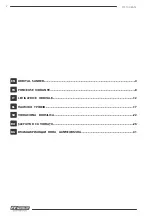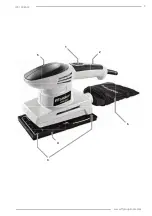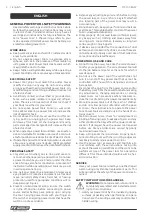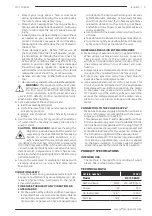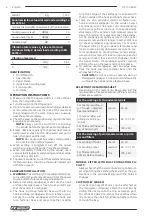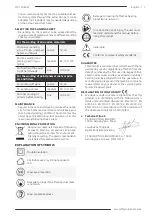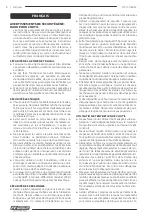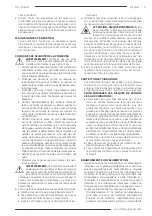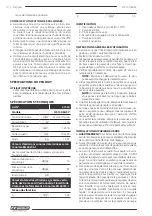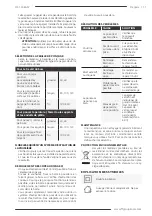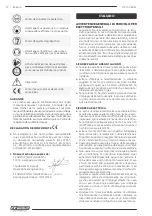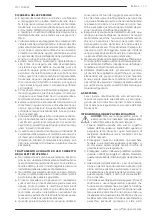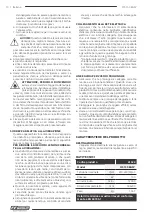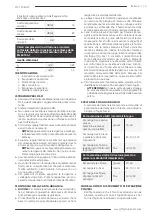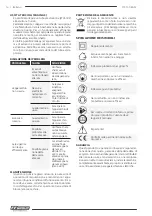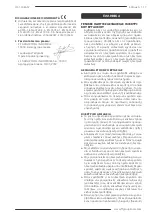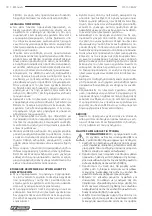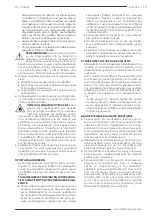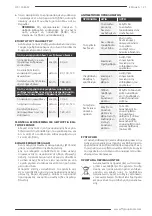
| English
6
OS 150 EASY
Weight
kg
1,557
Sound emission values determined according to
EN 60745-1
Typically the A-weighted noise levels of the product are:
Sound pressure level
dB(A)
76
Sound power level
dB(A)
87
Uncertainty K
dB
3
Vibration total values a
h
(triax vector sum)
and uncertainty K determined according to EN
60745-1
Vibration level max:
a
h
m/s
2
4,83
K
m/s
2
1,5
IDENTIFICATION
1.
On/Off Switch
2. Rear Handle
3. Paper Clamp
4. Hook & loop sanding base
5. Front Handle
6. Dust Box
OPERATION INSTRUCTIONS
f
Make sure that the power switch
is in the off-posi
-
tion, then plug in the tool.
f
Turn the switch to the ON position.
f
Do not use excess pressure while sanding and always
sand in same direction as the grain of the wood. Let
the sandpaper do the work. Apply even pressure
over the entire workpiece.
f
Check the wear on the sandpaper at regular intervals
and replace as necessary.
NOTE:
Always turn the switch OFF and unplug
the sander before changing sheets of sandpaper.
f
Empty dust box regularly for optimal dust pick-up
performance. Press button downward and pull it
open, then pour out the dust.
NOTE:
Do not use dust box when sanding metal.
Do not clean the dust box by water.
f
When sanding is completed, turn off the power
switch and remove the sander from the workpiece.
f
When completely finished using the sander, use a
vacuum to dislodge all sand shavings and dust. Wipe
with a clean, soft cloth.
f
To prevent accidents, turn off the sander and unplug
it after use. Clean, then store the sander indoors out
of children’s reach.
SANDPAPER INSTALLATION
f
WARNING:
To avoid injury from accidental startups,
turn switch OFF and remove the plug from the power
source outlet before making any adjustments.
f
Before installing sandpaper, make sure the hook
and loop fastener base is free of dust and dirt and
that the sander is unplugged.
f
The hook and loop fastener base will hold any
hook and loop sandpaper without clamps or glue.
Simply line up the sandpaper with the hook and
loop fastener base and press together, making
sure front edge of the sandpaper is aligned with
the front edge of the hook and loop fastener base.
f
There are also provided clamps to fasten non-
hook-and-loop sandpaper to the sander. Select
a sandpaper with the correct grit corresponding
to the work to be carried out. To take maximum
advantage of the sander’s high removal rate and
smooth finishing. It is essential that the sandpa
-
per be properly and tightly secured. Tight paper
also wears less and lasts longer. Insert end of new
1/4 sheet sandpaper approximately 1.5cm under
the paper clamp. Lift up on paper clamp lever and
lock into place. Apply downward pressure to con-
form sandpaper to sanding base. Wrap sandpa-
per around cushion. Lift lever on opposite end of
sander and insert loose end of sandpaper under
the paper clamp. Fit sandpaper against cushion
tightly. Lift up on the lever and lock into place.
f
To remove used sandpaper, peel one edge away
from the hook and loop fastener base until the
whole sheet is free.
CAUTION:
Do not use torn or severely worn or
damaged sandpaper. To do so could damage the
surface of the hook and loop fastener base.
SELECTING THE SANDING SHEET
Depending on the material to be worked and the
required rate of material removal, different sanding
sheets are available:
For the working of all wooden materials
For coarse - sanding, e.
g. of rough, unplaned
beams and boards
coarse
40, 60
For face sanding and
planing small irregu-
larities
medium
80, 100, 120
For finish and fine sand
-
ing of hard woods
fine
180, 240
For the working of paint/enamel coats or prim-
ers and fillers
For sanding off paint
coarse
40, 60
For sanding primer
medium
80, 100, 120
For final sanding of
primers before coating
fine
180, 240
MODELS FITTED WITH DUST EXTRACTION FA-
CILITY
Always check that the suction hole are not obstruct-
ed when fitting the sanding sheet and that the per
-
forations in the sand sheet align with the holes in
the base.
CHIP OUTLET (PAGE 3)
An extraction hose (Ø 35 mm), can be attached on
the chip ejector. If desired, attach the dust box by
sliding the nozzle onto the chip extraction port.
For efficient operation, empty the dust box when
it is no more than half full, allowing better airflow
through the bag.
Содержание 41524
Страница 3: ...www ffgroup tools com 3 OS 150 EASY 2 1 3 6 5 4...
Страница 18: ...18 OS 150 EASY FI RCD f f f f f f f f f f f f f f f f f f f f f f f f f f f f SERVICE 1 2 3 4 5...
Страница 19: ...19 www ffgroup tools com OS 150 EASY 6 7 f f f f f f Raynaud II f f f f f f f f OFF...
Страница 32: ...32 OS 150 EASY f f f f f f f f 1 2 3 4 5 6 7 f f f f f f...


